Laravel 5.5 core architecture detailed explanation
This article mainly introduces you to some in-depth understanding of the core architecture of Laravel 5.5. The article introduces it in great detail through pictures, texts and sample codes. Friends in need can refer to it. Let's learn together with the editor.
1. Dependency injection
method passes in the component name, and the framework will automatically instantiate it. You can use it directly in the method
For example, the most commonly used requert object
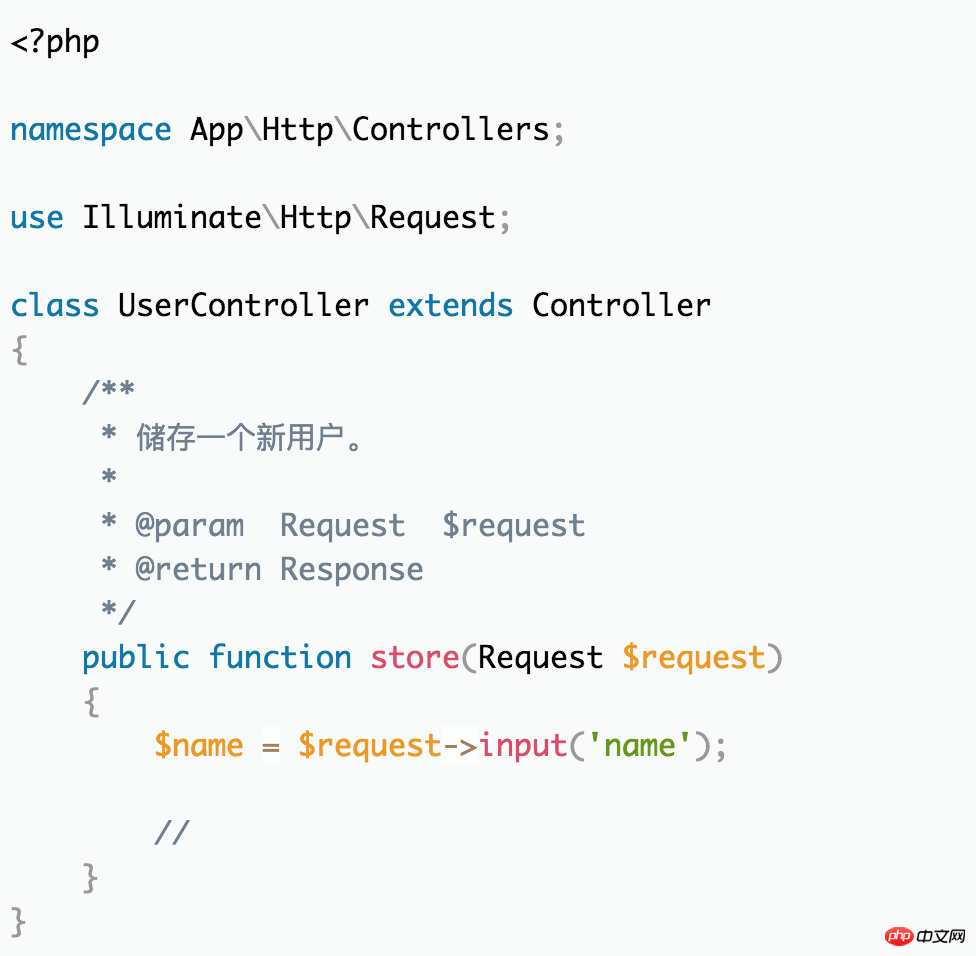
2. Service container
In fact, the core of Laravel is an IoC container. The core of Laravel itself is very lightweight, and there is nothing magical or substantial about it. Application functions. Various functional modules used by many people, such as Route (routing), Eloquent ORM (database ORM component), Request (request), Response (response), etc., are actually provided by class modules that have nothing to do with the core. The process from registration to instantiation of these classes to finally being used by you is actually the responsibility of Laravel's service container.
The service provider is mainly divided into two parts, register (registration) and boot (boot, initialization)
3. Service provider
A class must be owned by the container To be able to extract, you must first register to this container. Since Laravel calls this container a service container, if we need a service, we must first register and bind the service to the container. Then the thing that provides the service and binds the service to the container is the service provider (Service Provider).
4. Add your own class to the IOC container
4.1. Create a new validate class
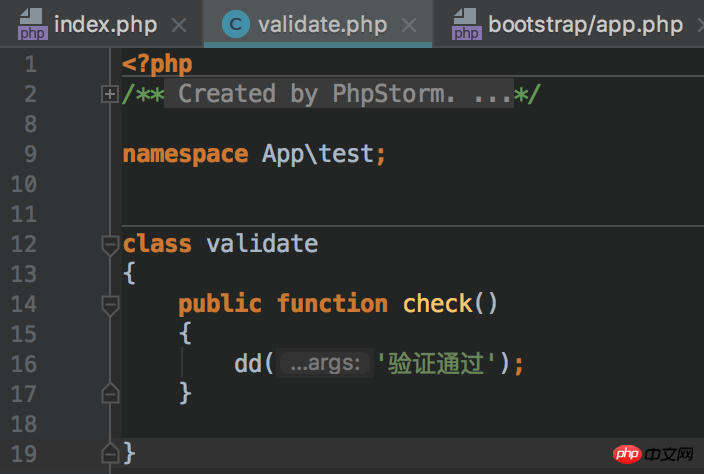
4.2. Create a new validateProvider

4.3. Bind the validate class to Provider
<?php
namespace App\Providers;
use Illuminate\Support\ServiceProvider;
class ValidateProvider extends ServiceProvider
{
/**
* Bootstrap the application services.
*
* @return void
*/
public function boot()
{
//
}
/**
* Register the application services.
*
* @return void
*/
public function register()
{
$this->app->bind('valicate',function(){
return new Validate();
});
}
}4.4. Add Provider to the IOC container
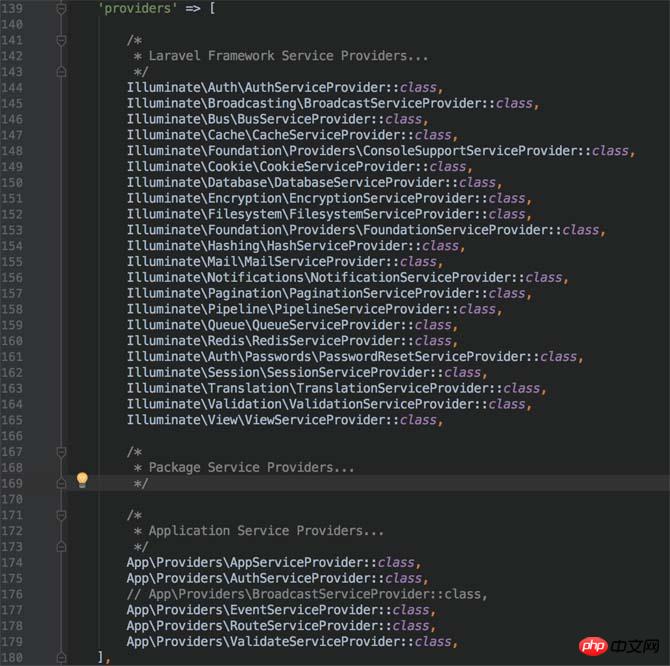
4.5. Use

4.6. Success!

5. Facade
The facade is used to provide a unified interface. For example, no matter which cache you use, redis or memcache, the client You can use cache::get() to get the value. Whether to use redis or memcahe depends on which one you bind to the service provider. The implementation of cache::get() is to inherit the Facade method getFacadeAccessor and return the key value you bind in the container, such as cache. Then the Facade class will use the PHP magic variable __callstatic(), and the callstatic logic will be from the container. Parse the service bound to the cache, which is who the service provider mentioned earlier is bound to
5.1, for example, mail
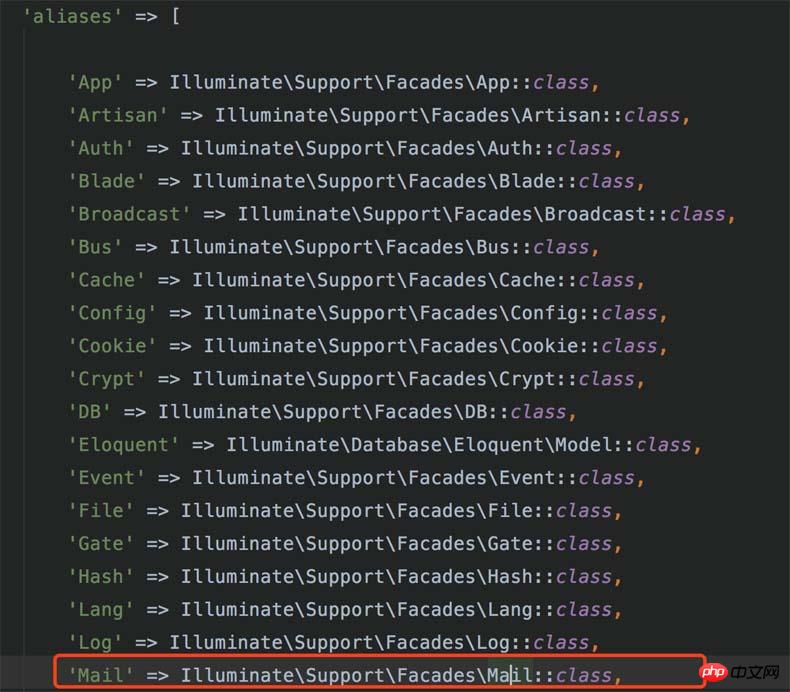
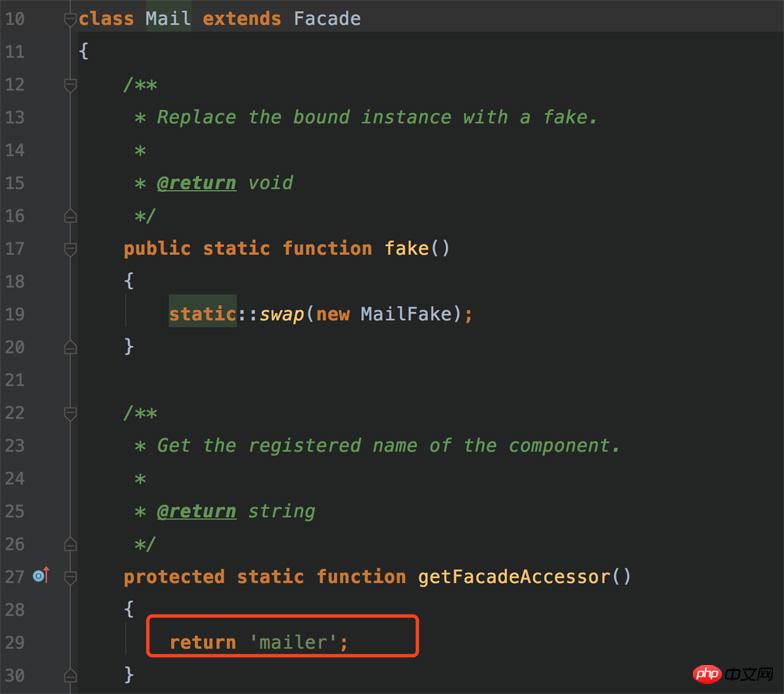
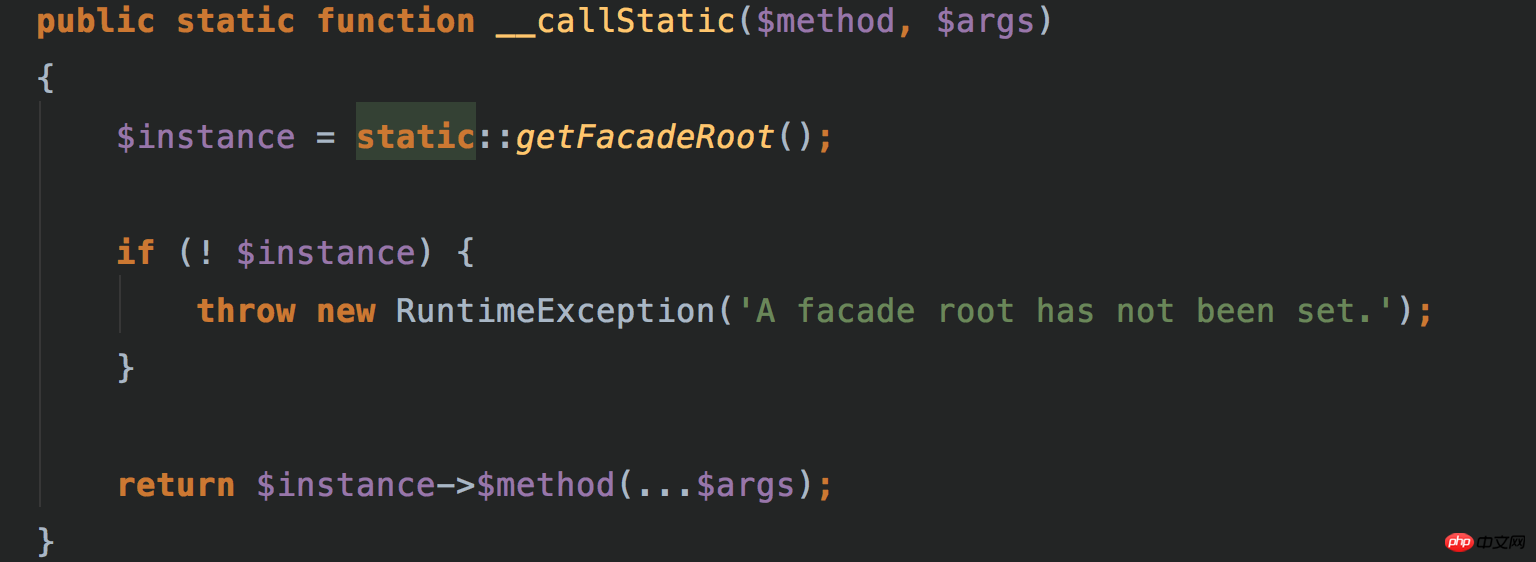


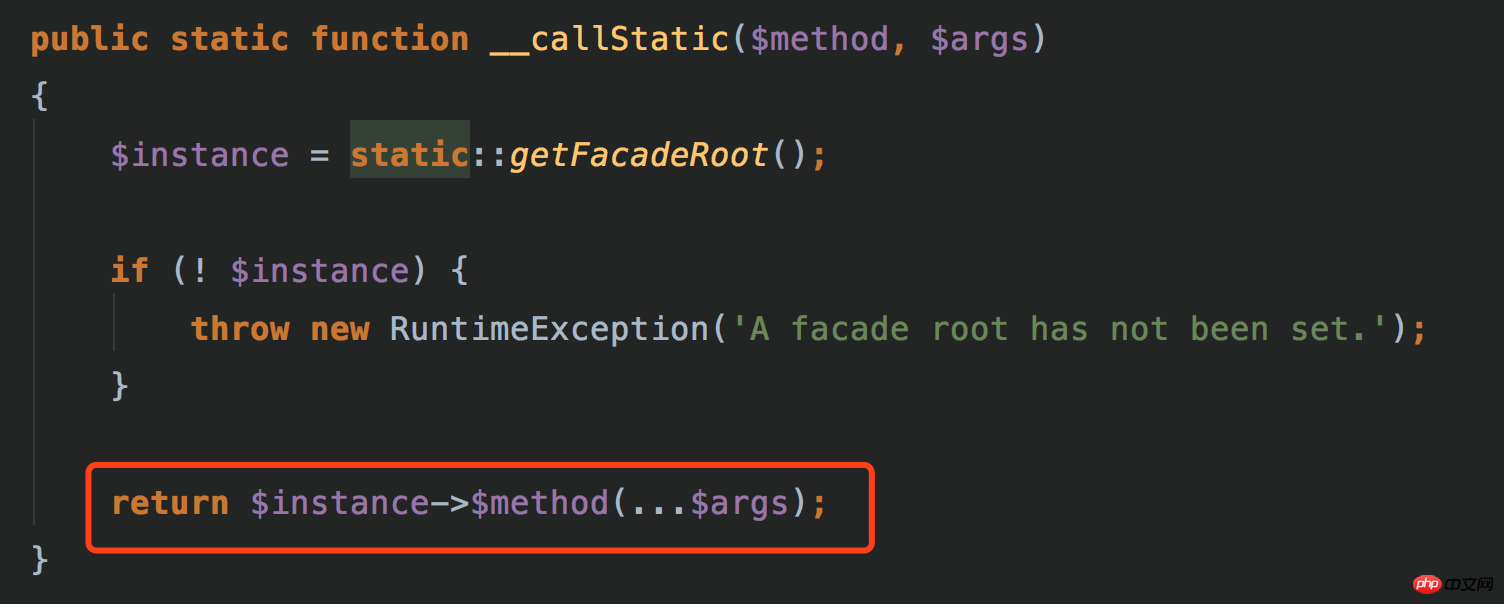
<?php
namespace App\Orders;
class Repository
{
/**
* 缓存实例。
*/
protected $cache;
/**
* 创建一个仓库实例。
*
* @param \SomePackage\Cache\Memcached $cache
* @return void
*/
public function __construct(\SomePackage\Cache\Memcached $cache)
{
$this->cache = $cache;
}
/**
* 按照 Id 检索订单
*
* @param int $id
* @return Order
*/
public function find($id)
{
if ($this->cache->has($id)) {
//
}
}
}<?php
namespace App\Orders;
use Illuminate\Contracts\Cache\Repository as Cache;
class Repository
{
/**
* 缓存实例。
*/
protected $cache;
/**
* 创建一个仓库实例。
*
* @param Cache $cache
* @return void
*/
public function __construct(Cache $cache)
{
$this->cache = $cache;
}
}现在,更改之后的代码没有与任何扩展包甚至是 Laravel 耦合。而契约扩展包不包含任何实现和依赖项,你可以轻松地写任何给定契约的替代实现,来实现不修改任何关于缓存消耗的代码就可以替换缓存实现。
相关推荐:
Laravel 5.5中为响应请求提供的可响应接口详解_php实例
The above is the detailed content of Laravel 5.5 core architecture detailed explanation. For more information, please follow other related articles on the PHP Chinese website!

Hot AI Tools

Undresser.AI Undress
AI-powered app for creating realistic nude photos

AI Clothes Remover
Online AI tool for removing clothes from photos.

Undress AI Tool
Undress images for free

Clothoff.io
AI clothes remover

AI Hentai Generator
Generate AI Hentai for free.

Hot Article

Hot Tools

Notepad++7.3.1
Easy-to-use and free code editor

SublimeText3 Chinese version
Chinese version, very easy to use

Zend Studio 13.0.1
Powerful PHP integrated development environment

Dreamweaver CS6
Visual web development tools

SublimeText3 Mac version
God-level code editing software (SublimeText3)

Hot Topics
 1377
1377
 52
52
 Comparison of the latest versions of Laravel and CodeIgniter
Jun 05, 2024 pm 05:29 PM
Comparison of the latest versions of Laravel and CodeIgniter
Jun 05, 2024 pm 05:29 PM
The latest versions of Laravel 9 and CodeIgniter 4 provide updated features and improvements. Laravel9 adopts MVC architecture and provides functions such as database migration, authentication and template engine. CodeIgniter4 uses HMVC architecture to provide routing, ORM and caching. In terms of performance, Laravel9's service provider-based design pattern and CodeIgniter4's lightweight framework give it excellent performance. In practical applications, Laravel9 is suitable for complex projects that require flexibility and powerful functions, while CodeIgniter4 is suitable for rapid development and small applications.
 How do the data processing capabilities in Laravel and CodeIgniter compare?
Jun 01, 2024 pm 01:34 PM
How do the data processing capabilities in Laravel and CodeIgniter compare?
Jun 01, 2024 pm 01:34 PM
Compare the data processing capabilities of Laravel and CodeIgniter: ORM: Laravel uses EloquentORM, which provides class-object relational mapping, while CodeIgniter uses ActiveRecord to represent the database model as a subclass of PHP classes. Query builder: Laravel has a flexible chained query API, while CodeIgniter’s query builder is simpler and array-based. Data validation: Laravel provides a Validator class that supports custom validation rules, while CodeIgniter has less built-in validation functions and requires manual coding of custom rules. Practical case: User registration example shows Lar
 Laravel - Artisan Commands
Aug 27, 2024 am 10:51 AM
Laravel - Artisan Commands
Aug 27, 2024 am 10:51 AM
Laravel - Artisan Commands - Laravel 5.7 comes with new way of treating and testing new commands. It includes a new feature of testing artisan commands and the demonstration is mentioned below ?
 Which one is more beginner-friendly, Laravel or CodeIgniter?
Jun 05, 2024 pm 07:50 PM
Which one is more beginner-friendly, Laravel or CodeIgniter?
Jun 05, 2024 pm 07:50 PM
For beginners, CodeIgniter has a gentler learning curve and fewer features, but covers basic needs. Laravel offers a wider feature set but has a slightly steeper learning curve. In terms of performance, both Laravel and CodeIgniter perform well. Laravel has more extensive documentation and active community support, while CodeIgniter is simpler, lightweight, and has strong security features. In the practical case of building a blogging application, Laravel's EloquentORM simplifies data manipulation, while CodeIgniter requires more manual configuration.
 Laravel vs CodeIgniter: Which framework is better for large projects?
Jun 04, 2024 am 09:09 AM
Laravel vs CodeIgniter: Which framework is better for large projects?
Jun 04, 2024 am 09:09 AM
When choosing a framework for large projects, Laravel and CodeIgniter each have their own advantages. Laravel is designed for enterprise-level applications, offering modular design, dependency injection, and a powerful feature set. CodeIgniter is a lightweight framework more suitable for small to medium-sized projects, emphasizing speed and ease of use. For large projects with complex requirements and a large number of users, Laravel's power and scalability are more suitable. For simple projects or situations with limited resources, CodeIgniter's lightweight and rapid development capabilities are more ideal.
 Questions and Answers on PHP Enterprise Application Microservice Architecture Design
May 07, 2024 am 09:36 AM
Questions and Answers on PHP Enterprise Application Microservice Architecture Design
May 07, 2024 am 09:36 AM
Microservice architecture uses PHP frameworks (such as Symfony and Laravel) to implement microservices and follows RESTful principles and standard data formats to design APIs. Microservices communicate via message queues, HTTP requests, or gRPC, and use tools such as Prometheus and ELKStack for monitoring and troubleshooting.
 Laravel vs CodeIgniter: Which framework is better for small projects?
Jun 04, 2024 pm 05:29 PM
Laravel vs CodeIgniter: Which framework is better for small projects?
Jun 04, 2024 pm 05:29 PM
For small projects, Laravel is suitable for larger projects that require strong functionality and security. CodeIgniter is suitable for very small projects that require lightweight and ease of use.
 Which is the better template engine, Laravel or CodeIgniter?
Jun 03, 2024 am 11:30 AM
Which is the better template engine, Laravel or CodeIgniter?
Jun 03, 2024 am 11:30 AM
Comparing Laravel's Blade and CodeIgniter's Twig template engine, choose based on project needs and personal preferences: Blade is based on MVC syntax, which encourages good code organization and template inheritance. Twig is a third-party library that provides flexible syntax, powerful filters, extended support, and security sandboxing.




